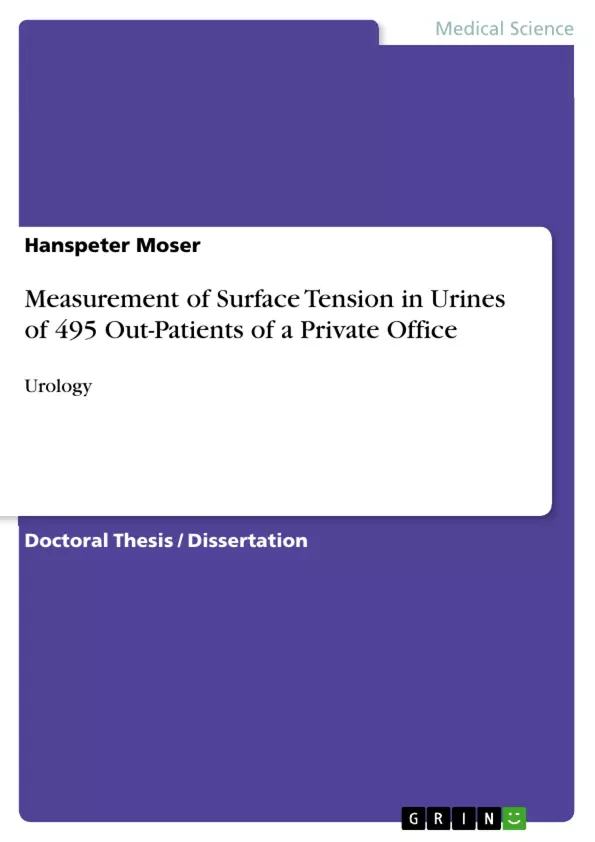In 1987, there was so far no data about surface tension in urine of different urologic disorders nor of physiologic human status.
That is why nearly 500 out-patients were seen and their urine measured twice with a ring tensiometer by Fa.Krüss, Hamburg.
Several proposals for methods to investigate the changes in the surface tension of biological or body fluids have been made already, since it has been suspected that such changes might reflect a pathophysiological status of the respective organism. Data on systematic measurements of the surface tension of various physiological fluids have been published, but not yet for urine during various urological diseases.
Measurements of the surface tension of amniotic fluid were carried out clinically in conjunction with the respiratory distress syndrome. Other measurements of the surface tension were performed on bile, blood, cerebrospinal fluid, serum, lymph, saliva and tears.
ABSOLOM et al. investigated in 1983, whether substrates with different surface tensions would induce a different degree of conformational change in adsorbed protein molecules, and whether these differences in the degree of change would be reflected by differences in the surface tension of the adsorbed layers. Their results were in good agreement with the relative hydrophobicity of the investigated proteins, as determined by other, independent
methods.
MYSELS carried out surface tension studies of bile salts dissolved in water with the purpose to show that, on the base of certain assumptions, the results of measurements of the surface tension of the solution may be translatable directly into the monomer activity and thus yield an indication for correlation. (...)
Inhaltsverzeichnis (Table of Contents)
- Introduction
- Surface Tension Measurement Methods
- Results
- Discussion
- Summary
- Literature
Zielsetzung und Themenschwerpunkte (Objectives and Key Themes)
The primary objective of this study was to investigate the surface tension of urine in a large cohort of out-patients with various urological conditions. The aim was to assess whether variations in surface tension could be observed in connection with different urological diseases and serve as a potential diagnostic tool.
- Surface tension of urine in various urological diseases
- Correlation between surface tension and specific urological conditions
- Potential diagnostic utility of surface tension measurement
- Physiological and pathophysiological implications of surface tension in urine
- Methods for measuring surface tension in biological fluids
Zusammenfassung der Kapitel (Chapter Summaries)
- Introduction: This chapter provides a background on the significance of surface tension in biological fluids, highlighting existing studies on surface tension in amniotic fluid, bile, blood, cerebrospinal fluid, serum, lymph, saliva, and tears. It also discusses the concept of surface active substances (surfactants) and their role in reducing surface tension.
- Surface Tension Measurement Methods: This chapter presents a comprehensive overview of various methods used for measuring surface tension, including force-based methods (ring method, plate method, stirrup method), pressure-based methods (capillary rise, gas bubble pressure), and optical methods (pending drop, sessile drop). It outlines the physical principles behind these techniques.
- Results: This chapter presents the findings of the study, including the surface tension measurements of urine samples from the 495 out-patients. It likely analyzes the data based on different urological conditions and compares the results to established norms.
- Discussion: This chapter discusses the implications of the study's findings, evaluating the potential of surface tension measurements as a diagnostic tool. It also likely explores the physiological and pathophysiological mechanisms underlying the observed variations in urine surface tension.
Schlüsselwörter (Keywords)
This study focuses on the measurement of surface tension in urine, with a particular emphasis on its potential diagnostic significance in various urological diseases. Key themes include surface tension, urine analysis, urological diseases, surface active substances, and different methods for measuring surface tension in biological fluids.
- Citation du texte
- Dr. Hanspeter Moser (Auteur), 1987, Measurement of Surface Tension in Urines of 495 Out-Patients of a Private Office, Munich, GRIN Verlag, https://www.grin.com/document/381210



